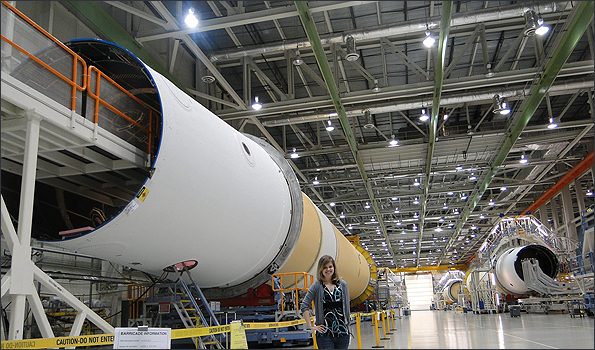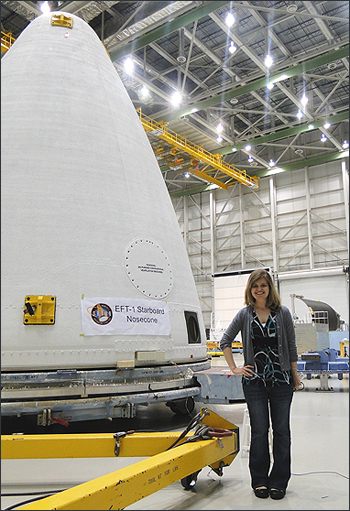
Tracie J. Prater has been selected to participate at the 2013 Emerging Space Leaders Grant Program during the 64th International Astronautical Congress in October in Beijing.
The 2012 graduate who earned a doctorate in mechanical engineering is the only American-born invitee of 12 chosen by the International Astronautical Federation out of more than 130 student applications from 38 countries.
The IAF is a consortium of government space agencies and 58 countries, and each year it funds several students and young professionals from around the world to present and participate in the emerging space leader program. Prater will present her own research there, but also will be part of a forum that gives students and young professionals the opportunity to brainstorm and interact with global space agency leaders on key space issues.
“I’m very interested in space policy, so this will be a great opportunity for me to learn and engage,” said Prater, currently working as a materials and processes engineer for United Launch Alliance in Alabama. “The program favors individuals from countries without a developed space infrastructure, so I was very lucky to be chosen. My advisers at Vanderbilt must have written some good recommendation letters.”
At ULA, a Lockheed-Boeing joint venture responsible for the design, manufacture and operation of the rockets in the Evolved Expendable Launch Vehicle (EELV) program, Prater works in manufacturing of fuel tanks for the Delta IV and Atlas V rockets which launch NASA, Air Force, and Department of Defense payloads into orbit.

Her ultimate goal is to be involved in design and development of new flight hardware for launch vehicles, which helps explain her continued independent research on the development of in-space welding capabilities. At Vanderbilt in 2008, Tracie was awarded a NASA graduate student research fellowship to study friction stir welding of metal matrix composites and evaluate the applicability of these materials to aerospace structures.
“In-space manufacturing is a hot topic right now, so that may have influenced my selection for the IAF program,” she said. “One of the great challenges of the long duration missions being considered by government agencies and commercial ventures is reducing astronaut’s dependency on earth. The ability to fabricate, assemble, and repair structures in space is a necessity for those missions.”
Her dissertation was on friction stir welding of metal matrix composites (MMC) and the work was funded through NASA. A robust welding capability is something that’s really needed to maintain and maximize the life of space structures. Prater says there are a number of materials with properties that are desirable for space structures or launch vehicle components, but their use is “limited by our ability to manufacture them.” MMCs are one such material.
“My research focused on identifying the best welding process for these materials, and then understanding and modeling the underlying phenomena during joining (material flow, wear processes) to increase the applicability of these materials across a number of industries where they may be of benefit,” she said. “Developing a fundamental understanding of a process is key to its successful implementation.”
Prater noted that there was a lot of research done on in-space welding during the 1980s and 90s and an electron beam welding unit was flown by the Russians on MIR and the United States on Skylab (the Russians used it to build a truss structure for solar cells). She said a lot of lessons learned from these experiments haven’t really been consolidated, so she’s vowed to use that work to propose a strategic path forward for in-space welding research.
She is author or co-author on nine academic peer-reviewed publications and has presented research at eight national and international conferences.
Her fascination with space travel began at an early age growing up under the stars in rural Kentucky and reading a lot of science fiction books, though a career in the space industry always seemed far-fetched to her until she reached Eastern Kentucky University, where she earned a bachelor’s degree in physics.
“It was only when I was at EKU that I started to believe I actually had the skill set needed to pursue a career in that sector,” Prater said. An obviously gifted student, Prater also received minors in English, statistics and mathematics from EKU before making the transition to engineering when she arrived at Vanderbilt.
“I had had some engineering courses as an undergrad (circuits, thermodynamics, classical mechanics, statics), and I found the Vanderbilt engineering school to be very welcoming to physics majors,” she said. “I didn’t really have a great deal of trouble transitioning, which reflects great on both EKU and Vanderbilt.”
After graduation Prater thought she might wind up working on launch vehicles at NASA — she began her career in aerospace as an intern at NASA Marshall Spaceflight Center as part of the NASA Academy Program — but found a new home in the commercial sector.
Prater hopes to have a career with a variety of experiences to help her gain a broad, system-level knowledge of launchers, from design to production to launch operations – a variety that saw Tracie volunteer to serve as a tour guide at the U.S. Space and Rocket Center in Huntsville, Ala. one summer during a NASA internship at MSFC. She has said that one of the most exciting moments of her life was viewing the final Space Shuttle launch from outside the Launch Control Center at Kennedy Space Center.
So is traveling in space on her list of experiences?
“I’m scared of everything, but I think ultimately I want to go to space myself,” Prater said, adding that increasing access to space is one of the great challenges of her generation. “I grew up reading science fiction and I always thought by now we would have space hotels and spaceports and mining colonies on the moon, so I’m excited to see those ideas emerging –and perhaps coming to fruition within the next few years — in the private sector or through public/private partnerships.”
Prater sees excitement in the private sector undertaking endeavors (such as Inspiration Mars Foundation) that used to be the domain only of government. Inspiration Mars is a nonprofit foundation that believes in the exploration of space as a catalyst for growth, national prosperity, knowledge and global leadership.
“I think they realize that in some ways exploration and research is its own reward. Maybe no one is demanding a reusable booster or a propellant depot right now, but I believe if you build it they will come,” she said. “There’s a quote from Walt Disney that I find particularly applicable to the space industry: ‘Times and conditions change so rapidly that we must keep our aim constantly focused on the future.’ You can’t stand still for too long if you want to remain viable in this emerging market.”